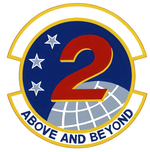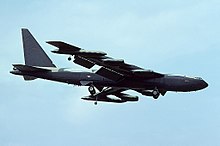2nd Bombardment Squadron
| 2nd Bombardment Squadron | |
|---|---|
 Air National Guard KC-135E deployed to RAF Mildenhall in 1989 | |
| Active | 1940–1963; 1963–1982; 1989–1992 |
| Country | |
| Branch | |
| Role | Control of deployed strategic units |
| Part of | Strategic Air Command |
| Motto(s) | Above and Beyond (1989–1992) |
| Engagements | Southwest Pacific Theater Korean War[1] |
| Decorations | Distinguished Unit Citation Air Force Outstanding Unit Award Philippine Presidential Unit Citation Republic of Korea Presidential Unit Citation[1][2] |
| Insignia | |
| 2d Strategic Squadron emblem (approved 1989)[3] |  |
| 2d Bombardment Squadron emblem (approved 15 April 1952)[1] |  |
| 2d Bombardment Squadron emblem (World War II)[4] |  |
The 2bd Bombardment Squadron is an inactive United States Air Force unit. Its last assignment as a Boeing B-52 Stratofortress squadron was with the Strategic Air Command 22nd Bombardment Wing stationed at March Air Force Base, California. It was inactivated on 1 October 1982. The unit was redesignated as the 2nd Strategic Squadron as a Boeing KC-135 Stratotanker rotational squadron with the 306th Strategic Wing and was last active at RAF Mildenhall, England in 1992.
History
World War II
Established as a medium bombardment squadron in 1940 under the Northeast Air District; equipped with Douglas B-18 Bolos and stationed at Langley Field, Virginia. Received early production Martin B-26 Marauder aircraft in late 1941. After the Pearl Harbor Attack, deployed to California] and flew antisubmarine patrols over the central and southern California coast.
Deployed to the new Fifth Air Force in Australia during February 1942, carrying out combat operations over Papua New Guinea in support of Allied ground forces engaging the invading Japanese beginning in April. Engaged in combat throughout the Southwest Pacific Area, being re-equipped with North American B-25 Mitchells in 1943, and long range Consolidated B-24 Liberator heavy bombers in 1944. Fought in the 1944–1945 Philippines Campaign, continuing raids on Japanese forces on Okinawa in 1945.
Squadron demobilized after the Japanese Capitulation, however carried as a Boeing B-29 Superfortress very heavy bomber unit and assigned to Twentieth Air Force in 1946 but not manned or equipped.
Strategic Air Command bombardment operations

Returned to the United States and assigned to Strategic Air Command (SAC) at March Air Force Base in 1948, operating B-29s. Deployed to Okinawa and flew combat operations over North Korea after the breakout of the Korean War in 1950, remaining attached to Far East Air Force Bomber Command until returning to the United States in October. Operated B-29s under SAC until 1953, upgraded to Boeing B-47 Stratojet medium bombers. Engaged in worldwide training exercises throughout the 1950s and early 1960s until the B-47 was phased out of the inventory.
Equipped with Boeing B-52B Stratofortresses for training in 1963; then operational B-52Ds in 1966. Deployed to Western Pacific bases during the Vietnam War and conducted combat operations over Indochina, engaging in Operation Arc Light, Linebacker I and Linebacker II raids over North Vietnam until 1973. Returned to the United States and stood nuclear alert until being inactivated in 1982.
Control of deployed Strategic Air Command aircraft
Reactivated with the 306th Strategic Wing in 1989 and operated the European Tanker Task Force rotational Boeing KC-135 Stratotanker aircraft operating from RAF Mildenhall.
Lineage
- Constituted as the 2d Bombardment Squadron on 1 January 1938
- Redesignated 2d Bombardment Squadron (Medium) on 6 December 1939
- Activated on 1 February 1940
- Redesignated 2d Bombardment Squadron, Heavy on 3 February 1944
- Redesignated 2d Bombardment Squadron, Very Heavy on 30 April 1946
- Redesignated 2d Bombardment Squadron, Medium on 28 July 1948
- Discontinued and inactivated on 15 March 1963[5]
- Redesignated 2d Bombardment Squadron, Heavy on 20 March 1963 and activated (not organized)
- Organized on 15 September 1963
- Inactivated on 1 October 1982
- Redesignated 2d Strategic Squadron on 19 December 1988
- Activated on 1 January 1989
- Inactivated on 31 March 1992
Assignments
- 22d Bombardment Group, 1 February 1940 (attached to 22d Bombardment Wing after 10 February 1951)
- 22d Bombardment Wing, 16 June 1952 – 15 March 1963[5]
- 22d Bombardment Wing, 15 September 1963 – 1 October 1982
- 306th Strategic Wing, 1 January 1989 – 31 March 1992
Stations
|
|
Aircraft
- Douglas B-18 Bolo, 1940–1941
- Martin B-26 Marauder, 1941–1943
- North American B-25 Mitchell, 1943–1944
- Consolidated B-24 Liberator, 1944–1945
- Boeing B-29 Superfortress, 1946–1953
- Boeing B-47 Stratojet, 1953–1963[5]
- Boeing B-52 Stratofortress
- B-52B, 1963–1966; B-52D, 1966–1982
- Boeing KC-135 Stratotanker, 1 January 1989 – 31 March 1992
See also
References
Notes
- ^ a b c Maurer, Combat Squadrons, pp.11–12
- ^ "Air Force Personnel Services: Unit Awards". Air Force Personnel Center. Archived from the original on 1 December 2018. Retrieved 4 April 2018. (search)
- ^ "Approved insignia for: 2d Strategic Squadron". from National Archives Catalog. 4 February 1986. Retrieved 4 April 2018.
- ^ Hubbard, p. 715
- ^ a b c d Lineage information, including assignments, through 3 March 1963 in Maurer, Combat Squadrons, pp. 11–12
Bibliography
![]() This article incorporates public domain material from the Air Force Historical Research Agency
This article incorporates public domain material from the Air Force Historical Research Agency
- Hubbard, Gerard (1943). "Aircraft Insignia, Spirit of Youth". The National Geographic Magazine. LXXXIII (6). National Geographic Society: 718–722. Retrieved 1 September 2017. (subscription required for web access)
- Maurer, Maurer, ed. (1983) [1961]. Air Force Combat Units of World War II (PDF) (reprint ed.). Washington, DC: Office of Air Force History. ISBN 0-912799-02-1. LCCN 61060979. Retrieved 17 December 2016.
- Maurer, Maurer, ed. (1982) [1969]. Combat Squadrons of the Air Force, World War II (PDF) (reprint ed.). Washington, DC: Office of Air Force History. ISBN 0-405-12194-6. LCCN 70605402. OCLC 72556. Retrieved 17 December 2016.
- Ravenstein, Charles A. (1984). Air Force Combat Wings, Lineage & Honors Histories 1947–1977. Washington, DC: Office of Air Force History. ISBN 0-912799-12-9. Retrieved 17 December 2016.
Further reading
- Brosius, J.W. Jr. (1944). The Marauder:A Book of the 22nd Bomb Group. Sydney, Australia: Halstead Press.
- Schroeder, Frederick A. (1985). Ducimus "We Lead" 22nd Bomb Group. Daytona Beach, FL: Hall Publishing Co.
- Watkins, Robert A. (2013). Insignia and Aircraft Markings of the U.S. Army Air Force in World War II. Vol. V, Pacific Theater of Operations. Atglen,PA: Shiffer Publishing, Ltd. pp. 72–73. ISBN 978-0-7643-4346-9. (Markings of unit B-24, B-25 and B-26 aircraft during World War II)


